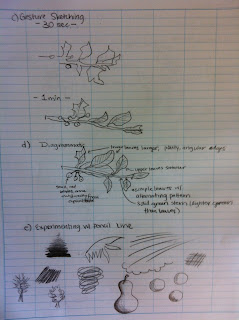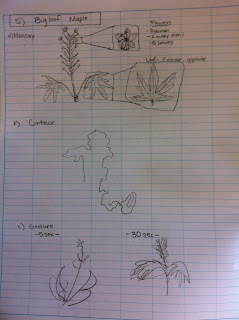Weather: cloudy, interspersed rain to sunny with clouds
Temp: 55 F
Time: 2:30pm-4:00pm
Location: Discovery Park
We set out again for our third week, cameras ready on macro setting, to continue observing phenotype changes in the species in our spot, as well as wander deeper into the park to find more species and natural areas. Coming out of the parking lot, we looked around for our old faithfuls.
 | |
| The red-flowering currant has started to develop fruits! |
 |
| Cones developing on the Nootka cypress |
The knobby, segmented female cones distinctive of Alaskan yellow cedar (nootka cypress) can be seen here dominating the picture while the little male strobili stay timidly far away on the tips of the branches. These branches also provided a quick resting spot for a fly.
 |
| "Maybe I should pick a less poky tree next time..." |
Looking around on the ground again, we spotted a new piece of vegetation hiding close to the ground, but with the nice, distinctive palmately lobed, rounded leaves of the genus Geranium.
 |
| Dovefoot Geranium |
Based on its small size and proximity to the ground, we identified it as Dovefoot Geranium. It is native to the Mediterranean and sub-Mediterranean areas, but is now naturalized in other parts of Europe, in southwestern and central Asia and in North Africa. It is an introduced species in North America, where it is known as Dovefoot Geranium or Awnless Geranium. While we normally think of geranium as a harmless, aesthetically pleasing flower, the plant is actually a noxious weed in the Pacific Northwest and quickly forms groundcover on open areas, among grasses, and in planting beds.
Moving back to the Bigleaf Maple, we noted the leaves appeared to be getting bigger and the catkins opening up more, preparing to fruit.
 |
| Bigleaf Maple catkin flower opens to reveal a quite whimsical pistil! |
 |
| ...And displaying its stamens/anthers in full force! |
The Elderberry flowers were also developing a nice white color and fully spreading open. They kind of make me think of tiny pieces of popcorn being popped...
 |
| Elderberry |
Next, we found a new species called Hawthorn, in the Rosaceae family.
 |
| Note the rose hips of the Hawthorn, distinguishing it as in the Rose family! |
It was helpful that I finally learned what rose hips are this week, so I knew what to look for (they are the round, reddish to brownish balls with the sepals fringed on top). Rose hips are the fruit of the rose plant. They begin to form after successful pollination of flowers in
spring or early summer, and ripen in late summer through autumn. Rose hips are used for jelly, syrup, soup, beverages, pies, bread, wine, and in teas. They can also be eaten raw, like a berry, if care is used to avoid the hairs inside the fruit. They have grown in popularity due to their high vitamin-C content, and thus rose hip tea is a common cold remedy.
This week we learned about the two common species of rose in the Pacific Northwest: Nootka rose and baldhip rose. We kept a lookout for those as well, and--fancy that!--we stumbled upon some Nootka rose, distinguished by the pinnate, compound leaves, with leaflets in 5-9 bunches and BIG curved thorns.
 |
| Nootka rose-those are the thorns your mother warned you about |
Next, we saw what we can only guess was a very old mushroom. It looked a bit Dr. Suess-esque, but showed no signs of leaf growth or remnants of any reproductive structures...
 |
| Fungus...or remnant of an ancient Truffula forest?! (see below) |
 |
| Maybe Dr. Suess was onto something |
 |
| Indian plum fruiting |
 |
| Small male cones. You know they're male when you flick them and pollen falls |
 |
| Female cones (see below for distinguishing feature of the female cones) |
| Douglas fir female cones have wing-like structures that appear to dangle out of the cone |
Next we saw Snowberry, also known as "corpse berry" (hope I don't have to explain the reason behind that one). It looks somewhat like Huckleberry, but while huckleberry has alternate leaves, snowberry's are opposite, and usually tinged with a little bit of red. Of course the white snowberries are usually a pretty good indicator when they are around...
 |
| Common Snowberry |
From far away, the peeling bark calls...and we find a Pacific Madrone.
 |
| Pacific Madrone |
 |
| Peeling bark of the madrone |
 |
| Distinct, bell-shaped flowers...must be Ericaceae! (same family as blueberries) |
We also found a plant that looked exactly like red-flowering currant, but the leaves were white. Some id-ing leads us to believe it is Sticky currant.
 |
| Sticky Currant |
As we ventured further into the natural, wooded areas of the park. We found many alders lining the path, which later turned to deeply shaded evergreen areas. Where the alders abounded, many small birds could be heard flittering around in them. I tried in vain to get a picture of a chesnut-backed chickadee we saw. I managed only to snap yet another picture of the much bolder robin. He looked slightly perturbed at my presence, possibly because we tried to sneak up on him while he was bathing in a nearby puddle...
 |
| "Seriously...stop following me around" |
On the way into the wooded areas we also noted many mangled looked, warty-barked trees. The strange structure and texture of the trunks both interested and perplexed us. We spotted many that had the same strange "warts" so it was hard to determine if these were some kind of nodule growth. We will try to id them at some point. Note: we have PROOF that the sun came out for awhile in these pictures (a rare treat for the Pacific Northwest naturalist!)
 |
| Warty trees? |
In this same area, we found Vinca vine growing in the alders' shade
 |
| Vinca |
A beetle resting on an alder leaf
As well as what was likely a House fly resting on some unknown shrub. We also found what we later identified as Fringecup |
| Fringecup |
We wandered down the path into the evergreen wooded area. Within the woods we did not identify many new species, except some very conspicuous licorice ferns
 |
| Licorice ferns just hanging out |
On the way back out, I noticed a new pine with giant needles. As I came closer I noticed its needles were in bundles of 3...Ponderosa pine!
 |
| Ponderosa pine. Pom-pom shaped needle structure |
 |
| A closer look revealed beautiful, majestic cone developing display. Females on the edges and males in the middle. |
We hope for Week 4 to bring us a bit more sun, as well as a chance to continue to see more change in our species phenotypes and behaviors!
Now, for a little exercise in species identification using some of the species we have found at Discovery Park:
1. Bigleaf Maple (Acer macrophyllum): Large tree species. Deciduous. Opposite light green 5-lobed palmate leaves (claw-like, hanging). Flowers form in hanging catkins and are greenish-yellow, about 3mm across. Fruits are golden-brown, paired winged seeds and the long wings that separate in a V-shape.
2. Western Red Cedar (Thuja plicata): Large evergreen conifer tree species. Leaves form in non-pointy scales. Leaves in opposite pairs in four rows in overlapping shingle assortment resembling a flattened braid. Glossy green color on leaves. Bark is reddish when mature and stringy. Reddish male cones remain very tiny on tips of branches while female seed cones are green when immature, then grow to become brown, woody and turned upwards with winged seeds.
3. Western Hemlock (Tsuga heterophylla): Large, up to 60 meters tall, evergreen tree species. Leaves in needles that are short, blunt, fat, irregularly spaced and usually unequal length (5-20mm long). Leaves are yellowish-green and top while underside is whitish with 2 fines lines of stomata. Male pollen cones numerous and small. Female cones are also quite small, 1-3cm in length.
4. Red-Flowering Currant (Ribes sanguineum): Grows in shrub form in tall, erect manner, 1-3m tall with crooked stems and reddish-brown bark. Deciduous. Leaves grow in alternate pattern and are regularly or irregularly 5-lobed and 2-6cm broad. The lower surface of the leaf is paler and hairier. Flowers are usually a deep magenta-pinkish color, though it appears the colorful petals are actually sepals, since there is a whitish rounded tubular structure that also protrudes out from the center that surrounds the stamens and pistil. The flower structure is tubular, with sepals separated into 5 parts and the flowers grow in drooping bundles of 10-20 flowers. Fruits are blue-black round berries 7-9mm and unpalatable.
5. Indian-Plum (Oemleria cerasiformis): Grows in large shrub or small tree form, 1.5-5m tall. One of the first plants to flower in the spring. Deciduous. Leaves alternate, pale green, soft and lance-shaped, 5-12 cm long. Non-serrated entire leaves that smell strongly of cucumber when crushed. Flowers are greenish-white bell-shaped and about 1 cm across. Male and female flowers grow on separate plants. Flowers have 5 petals, 15 stamens and hang in 5-10cm long clusters from leaf axils. Fruits are small and ripen from a peach to a bluish-black color with a whitish bloom and look like small plums about 1 cm long, edible but bitter with a large pit.
6. Cleavers (Galium aparine): Weak, herbaceous, tap-rooted annual. Grow low to ground, 20-100cm tall. Leaves in whorls of 6-8 linear, oblong, 1 veined structure. Have bristles on underside up leaf that will attach to fabric such as cotton and will stick to some clothing. Flowers are whitish or greenish and small, 1-2mm wide, with petals fused at the base into a very short tube that spreads into 4 lobes . Fruits are dry 2-lobed little burs covered with hooked bristles.7. Ponderosa Pine (Pinus ponderosa): Large evergreen conifer tree species. Bark is scaly and cinnamon-colored. Leaves are distinctively long needles (compared to other pines), 10-20cm, and grow in bundles of 3 needles and branches can grow sloping downwards in mature trees. Cones grow in circular nest-like structure surrounded by a bunch of pines in a pom-pom structure. The cones grow with rows of female, oval cones on the outside and small, male cones in the center. Female cones mature from purple-brown color to brown and males become long and erect
8. Common Snowberry (Symphoricarpos albus): Grow in shrub form, erect, from .5-2m tall. Opposite branching with young hairless stems and fine twigs. Deciduous. Opposite, elliptic to oval leaves 2-5 cm long and may be lobed on young stems. Edges smooth to wavy-toothed. Flowers are pink to white, bell-shaped and 5-7mm in short dense clusters of few flowers, mostly terminal. Fruits are in clusters of white berries, 6-15mm across and are inedible to humans, though palatable to other animals such as birds.





































